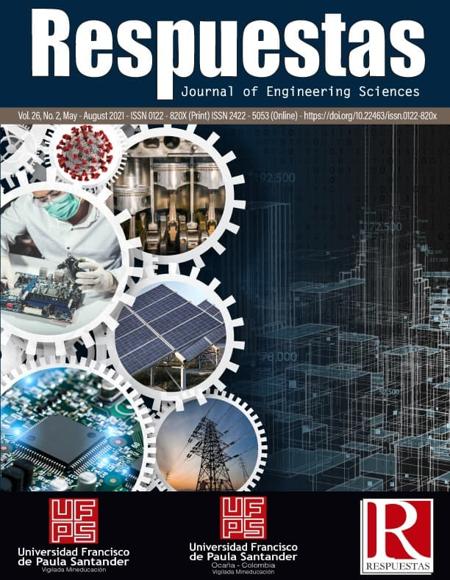Flow Monitoring and Analysis in Sanitary Sewer Systems in Cúcuta, Colombia
Monitorización y análisis de flujo en sistemas de alcantarillado sanitario en Cúcuta, Colombia
Main Article Content
Monitoring the flow of sewerage systems allows us to know the real behavior of each system and serves as a fundamental tool in wastewater management. For the design of sewerage systems, it is necessary to know the wastewater flows that will be transported by the system and, based on these volumes, the factors that represent the consumption patterns and the characteristics of each community must be estimated. In the absence of information, these factors should be estimated with existing empirical equations developed in research carried out in different cities around the world. The main objective of this research is to estimate the factors specific to the sanitary sewerage system of San José de Cúcuta, for this purpose, the monitoring of the wastewater flow was implemented for 19 weeks, and upon analyzing the data, the hourly variation of the flow entering the system was obtained, and based on the measured flows, a major factor was determined, which represents the characteristics of the city; The factor obtained was also compared with the results of the existing empirical equations and it was possible to identify which of these equations best fit the monitoring campaigns.
Downloads
Article Details
C. A. Bonilla, J. C. Barrera y O. G. Cifuentes, “A systematic review of wastewater monitoring and its applications in urban drainage systems”, Respuestas, vol. 24, no. 3, pp. 54–64, 2019. DOI: https://doi.org/10.22463/0122820X.1836
N. J. Cely, C. A. Bonilla y J. P. Rojas, “Statistical analysis of wastewater monitoring for maximum peak factor estimation”, Journal of Physics: Conference Series, vol. 1981, no. 1, pp. 012013, 2021. DOI: https://doi.org/10.1088/1742-6596/1981/1/012013
J. S. Blanco Cáceres y O. M. Duque Suárez, “Ingeniería de mantenimiento basada en confiabilidad a los equipos altamente críticos de la Empresa Comercializadora LICRATEX C.A”, Mundo Fesc, vol. 8, no. 15, pp. 41-48, 2018.
E. H. Imam y H. Y. Elnakar, “Design flow factors for sewerage systems in small arid communities”, Journal of Advanced Research, vol. 5, no. 5, pp. 537–542, 2014. DOI: https://doi.org/10.1016/j.jare.2013.06.011
Metcalf, y Eddy, Ingeniería de aguas residuales: tratamiento, vertido y reutilización. Madrid: McGraw Hill, Tercera edición, 1985.
G. Munksgaard y J. C. Young, “Flow an Load Variations At Wastewater Treatment Plants”, Journal: Water Pollution Control Federation, vol. 52, no. 8, pp. 2131–2144, 1980.
Ministerio de Vivienda, Ciudad y Territorio 2018 Resolución 0330 (Colombia: Ministerio de Vivienda, Ciudad y Territorio).
M. C. Elvy, “Development of Infiltration Factors for the Estimation of Urban Separate Wastewater Flow in the Gippsland Water Catchment Courses ENG4111 and ENG4112 Research Project towards the degree of”, Lic. Thesis, University of Southern Queensland, Australia, 2004.
X. Zhang, S. G. Buchberger, y J. E. van, “A Theoretical Explanation for Peaking Factors”, Congreso Mundial de Recursos Hídricos y Ambientales, pp. 1–12, 2005. DOI: https://doi.org/10.1061/40792(173)51
A. Karimzadeh, O. Shoghli, & S. Kaykhosravi, “A Comparison of Peaking Factor of Real Measured Flow Data in Tehran and Isfahan Wastewater Collection System with Empirical Formulas”, World Environmental and Water Resources Congress, 2018. DOI: https://doi.org/10.1061/9780784481431.034
G. Balacco, A. Carbonara, A. Gioia, V. Iacobellis, A. Piccinni, G. Balacco, A. Carbonara, A. Gioia, V. Iacobellis, y A. F. Piccinni, “Evaluation of Peak Water Demand Factors in Puglia (Southern Italy)”, Water, vol. 9, no. 2, pp. 96, 2017. DOI: https://doi.org/10.3390/w9020096
Environmental Protection Agency (EPA) 1997, “Process design manual: wastewater treatment facilities for sewered small communities” EPA. Camp, Dressler & McKee, Inc., Boston, MA.
J. P. Rodriguez, Mcintyre, M. Díaz, y C. Maksimovi, “Monitoring and modelling to support wastewater system management in developing mega-cities. Science of the Total Environment”, Science of the Total Environment, vol. 446, no. 19, pp. 79–93, 2013. DOI: https://doi.org/10.1016/j.scitotenv.2012.12.022
R. A. López, “Diseño de acueductos y alcantarillados”, E. C. de Ingeniería, Alfaomega, 2003.
P. R. Sayago Rojas, “Impacto socioeconómico a un año del cierre de la frontera Colombo-Venezolana: Norte de Santander – Estado Táchira (2015-2016)”, Mundo Fesc, vol. 6, no. 12, pp. 86-97, 2017.
E. Empresas Públicas de Medellín 2009, Normas de Diseño de Sistemas de Alcantarillado de EPM (Medellín: In Empresas Públicas de Medellín E.S.P).
J. Gaines, “Peak Sewage Flow Rate: Prediction and Probability”, Journal: Water Pollution Control Federation, vol. 61, no. 7, pp. 1241-1248, 1989.
R. B. Moulton, “Peaking factors in sanitary sewer design. Brigham Young University”, Provo: Utah. 1999.
A. Zambrano N 2015, “Recolección de aguas residuales” (Leomine Editores: Universidad del Cauca, primera edición).
L. Vargas-Garay, O. Torres-Goyeneche y G. Carrillo-Soto, “Evaluation of SCS - unit hydrograph model to estimate peak flows in watersheds of Norte de Santander”, Respuestas, vol. 24, no. 1, pp. 6-16, 2019. DOI: https://doi.org/10.22463/0122820X.1743
J. R. Hechavarría, A. Cordovés y M. García, “Sistema para el cálculo de redes de acueducto”, Respuestas, vol. 6, no. 1, pp. 3–11, 2016. DOI: https://doi.org/10.22463/0122820X.604
A. Chandragade y R. Gupta, “Peak factor curve for estimating peak flows in design of sewer networks: a case study of Gadchiroli city”, International Journal of Innovative Research in Science and Engineering, vol. 2, no. 12, pp. 162, 2016.







